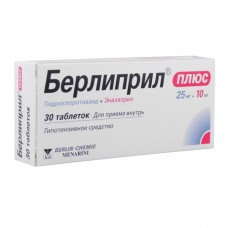Expiration date: 01/2026
Form release
Tablets
Composition
1 tablet contains enalapril maleate 10 mg hydrochlorothiazide 25 mg
Packaging
30 PCs.
Pharmacological action
Berlipril plus is a combined drug consisting of enalapril - an angiotensin converting enzyme inhibitor (ACE) and hydrochlorothiazide - thiazide diuretic, which potentiate the action of each other, and their antihypertensive effect is summed.
Enalapril inhibits the enzyme that catalyzes the conversion of angiotensin I to angiotensin II-peptide with vasoconstrictor action, with a weakening of vasoconstrictor activity and a decrease in the secretion of aldosterone, which can lead to an increase in the potassium content in the blood serum with simultaneous excretion of sodium and liquid. Elimination of the negative reverse effect of angiotensin II on renin secretion leads to the activation of plasma renin. The mechanism of enalapril blood PRESSURE reduction is based on the primary suppression of the activity of the renin-angiotensin-aldosterone system (RAAS). ACE is identical to kininase II-an enzyme that catalyzes the breakdown of bradykinin-a peptide with potential vasodilating effect. This plays an additional role in the implementation of the antihypertensive effect of enalapril.
The use of enalapril in patients with hypertension leads to a decrease in blood PRESSURE both in the "standing" and in the "lying" position, without a significant increase in heart rate.
Hydrochlorothiazide disrupts the reabsorption of sodium, chlorine and water in the renal tubules. Increases the excretion of potassium, magnesium, hydrocarbonates, detains calcium ions in the body. The diuretic effect develops after 2 hours after intake of hydrochlorothiazide inside, reaches a maximum of 4 hours and remains up to 12 hours. Reduces elevated blood PRESSURE.
With the simultaneous use of enalapril and hydrochlorothiazide, potassium losses associated with the action of diuretic are reduced, thereby preventing the development of hypokalemia.
Indications
Essential hypertension I-II degree (patients who are shown combination therapy or with insufficient effectiveness of enalapril monotherapy).
Contraindications
- hypersensitivity (including to other sulfonamide derivatives),
- anuria,
- an anamnesis of angioedema associated with ACE inhibitors,
- hereditary or idiopathic angioedema,
- pregnancy,
- lactation,
- childhood.
Caution: renal/hepatic failure, severe systemic connective tissue diseases (including SLE, scleroderma), bilateral renal artery stenosis, stenosis of artery only kidneys, condition after kidney transplantation, aortic stenosis, congestive heart failure, coronary artery disease, oppression kostnomozgovy blood, cerebrovascular disease (including cerebrovascular insufficiency), diabetes mellitus, hyperglycaemia, diet with restriction of sodium, of condition, accompanied by a decrease in BCC (W. diarrhea, vomiting), old age.
Method of application and doses
The drug is taken orally, regardless of food intake, 1-2 tablets 1 time / day. (in patients with reduced glomerular filtration rate is 30 ml/min require individual selection of doses, in terms of amlodipine 5-10 mg/day.).
Side effect
Possible side effects when using the drug berlipril® plus, as in monotherapy with active components separately, are given below in the descending frequency of occurrence: (>, 1/100, <, 1="" 10="">, 1/1000, <, 1="" 100="">, 1/10000, <, 1="" 1000="" 10000="" p="">,
From the nervous system: often-headache, systemic dizziness, increased fatigue, infrequently - drowsiness or insomnia, depression, paresthesia, increased excitability, confusion, tinnitus, accommodation disorders, changes in taste perception, asthenia.
From the cardiovascular system: often-marked decrease in blood PRESSURE regardless of body position, infrequent - arrhythmia, loss of consciousness, in some cases - tachycardia, palpitations, angina pectoris, chest pain, myocardial infarction, cerebral circulation disorders, stroke.
From the respiratory system, chest and mediastinal organs: often-cough (disappears after discontinuation of the drug), infrequently - dyspnea, sinusitis, rhinitis, in some cases - bronchospasm, stomatitis, glossitis, pulmonary edema, interstitial pneumonia.
From the gastrointestinal / liver and biliary tract: infrequently-nausea, abdominal pain, digestive disorders, dry mouth mucosa, diarrhea, vomiting, pancreatitis, constipation, flatulence, anorexia, in some cases - hepatitis and intestinal obstruction, very rarely reported the development of angioedema associated with taking ACE inhibitors, including enalapril.
From the skin: infrequently-itching, rash, dry skin, rarely - angioedema of the face, limbs, lips, tongue, glottis and/or larynx, sweating, photosensitization, very rarely - Stevens-Johnson syndrome.
From the side of musculoskeletal system: infrequently - muscle spasm and pain.
From the kidneys and urinary tract: infrequently - renal dysfunction, renal failure, proteinuria, interstitial nephritis.
From the genital organs and mammary glands: rarely - violation of potency.
Laboratory findings: infrequently-hypercholesterolemia, hyperglycemia, hyperlipidemia, hypokalemia, hyperkalemia, hyperuricemia, hyponatremia, hypochloremia, hypercalcemia. hypomagnesemia, increased serum creatinine, blood urea and liver function tests, decreased hemoglobin and hematocrit, rarely-increased activity of "hepatic" transaminases and bilirubin concentration.
The following symptoms are described: fever, myalgia/myositis, arthralgia/arthritis, vasculitis, serositis, eosinophilia, leukocytosis, increased erythrocyte sedimentation rate (ESR), positive test for antinuclear antibodies.
Other: decreased libido, gout, arthralgia.
Special instruction
Therapy should be discontinued before the study of the function of the parathyroid glands.
Is subjected to dialysis. Dosage adjustment on days when dialysis is not performed, should be carried out depending on the level of blood PRESSURE.
Before and during treatment, it is necessary to control blood PRESSURE, kidney function, potassium concentration in plasma.
Care should be taken when prescribing patients with reduced BCC (as a result of diuretic therapy, with limited salt intake, hemodialysis, diarrhea and vomiting) due to increased risk of sudden hypotension after applying even the initial dose. Transient hypotension is not a contraindication to continue treatment with the drug after stabilization of blood PRESSURE. In the case of repeated occurrence of severe hypotension should reduce the dose or cancel the drug.
In the case of excessive hypotension, the patient is transferred to a horizontal position with a low headboard, if necessary, a 0.9% sodium chloride solution is introduced (to increase the plasma volume).
It should be observed in patients with decompensated chronic heart failure, coronary artery disease and cerebrovascular disease, in which a sharp decrease in blood PRESSURE can lead to myocardial infarction or stroke, impaired renal function.
It is not recommended to use an69 dialysis membranes in combination with ACE inhibitors.
Drug interaction
Hypotensive effect reduces NSAIDs, estrogens, ethanol, increase - diuretics, General anesthesia, antihypertensive drugs, hemodialysis.
Immunosuppressants, allopurinol, cytostatics increase the risk of hematotoxicity.
It enhances the action of ethanol and slows down the excretion of lithium.
Simultaneous administration with beta-blockers, slow calcium channel blockers increases the risk of hypotension.
Overdose
Symptoms: excessive lowering AD until development of collapse, infarction, acute violation of cerebral circulation or thromboembolic complications, cramps, stupor.
Treatment: gastric lavage, oral salt solution,/in the introduction of plasma substitutes, angiotensin II, hemodialysis (rate of excretion - 62 ml/min).
Storage conditions
Store at a temperature not exceeding 30°C out of reach of children.
Berlipril
Plus
(Hydrochlorothiazide
+
Enalapril)
25mg
+
10mg
30
tablets
- Brand: Berlin-chemie

Categories:
-
$9.00

